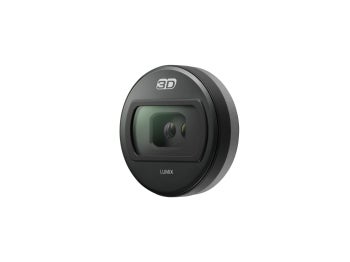The Panasonic Lumix DMC-GH2 replaces the GH1 at the top end of the Micro Four Thirds lineup, offering touch controls, a new image-processing engine, fast autofocus, a quicker burst mode, and video improvements.
 All the way back in 2008, Panasonic introduced interchangeable-lens, mirrorless cameras to the world with the debut of the Lumix G1.
Earlier this year, the company replaced that first-generation model
with the first touchscreen-operated interchangeable-lens camera, the midrange Lumix DMC-G2.
And now, Panasonic has added those touchscreen controls to its
highest-end Micro Four Thirds G-series camera, the just-announced Lumix
DMC-GH2.
All the way back in 2008, Panasonic introduced interchangeable-lens, mirrorless cameras to the world with the debut of the Lumix G1.
Earlier this year, the company replaced that first-generation model
with the first touchscreen-operated interchangeable-lens camera, the midrange Lumix DMC-G2.
And now, Panasonic has added those touchscreen controls to its
highest-end Micro Four Thirds G-series camera, the just-announced Lumix
DMC-GH2.The new GH2 replaces last year's Lumix GH1 at the top of the Lumix G-series line, offering revamped image processing, fast autofocus, a quicker burst-shooting mode, and a flip-out touchscreen to go along with its eye-level electronic viewfinder. Panasonic also introduced three new lenses for the Micro Four Thirds mount, including a 3D attachment that reared its dual-lensed head earlier this year.
Panasonic Lumix DMC-GH2: Touchscreen Controls, Performance Boosts
 The
GH2 is the first Lumix interchangeable-lens camera to feature the Venus
VI FHD processing engine, which is based on a three-core CPU. According
to Panasonic, the new Venus engine is the secret behind the camera's
improved dynamic range and high-ISO noise handling, its faster
burst-shooting mode, and its very fast autofocus (the company claims
the camera can lock on a sharp image in just 1/10 of a second).
The
GH2 is the first Lumix interchangeable-lens camera to feature the Venus
VI FHD processing engine, which is based on a three-core CPU. According
to Panasonic, the new Venus engine is the secret behind the camera's
improved dynamic range and high-ISO noise handling, its faster
burst-shooting mode, and its very fast autofocus (the company claims
the camera can lock on a sharp image in just 1/10 of a second).Although it has the same size CMOS sensor as previous Lumix Micro Four Thirds cameras, the GH2 gets a resolution boost to 16 megapixels (up from 12 megapixels in previous interchangeable-lens Lumix models). The new camera also improves its video capabilities to 1920-by-1080 high-definition AVCHD video recording at 60 interlaced frames per second; and when capturing video at 24 fps, it uses the maximum 24-mbps bitrate supported by the AVCHD format.

The GH2 has a pop-up flash and built-in stereo microphones with wind-noise-reduction technology, as well as a proprietary hot shoe that can support external flashes and microphones. It's also the first G-series camera to support the ability to feed the Live View signal out to an HDTV or secondary monitor in real time, via an HDMI connection.
In addition to menu navigation and touch-controlled image and video playback, the camera's 3-inch touchscreen offers shooting controls such as touch-to-focus, selecting on-screen subjects for motion-tracking autofocus, and a touch-controlled shutter. While shooting video, you can use touch-to-focus controls to switch focus on different objects in the scene. Panasonic also claims that the color reproduction on the touchscreen LCD viewfinder--as well as the quality of the viewfinder itself--has been improved with the new model.
Though touchscreens certainly aren't for everyone, the Lumix DMC-GH2 implements its touchscreen functionality in the right way: The touchscreen isn't the only option for navigating menus and composing shots, as photographers have the freedom to choose between using the camera's hardware controls or the touchscreen. During my hands-on demo time with the camera, the touchscreen's response times were sharp, the autofocus was lightning-fast, and the touch-to-focus controls seemed to be a great addition to a camera with powerful optics and video capabilities.
The camera offers variable burst modes that reach up to 40 fps at a reduced 4-megapixel resolution, as well as a 5-fps burst mode at full 16-megapixel resolution. ISO equivalency settings also get a boost, as the GH2 maxes out at ISO 12800; in addition, it offers the same noise-reduction process as the recently announced Lumix LX5. Panasonic has added Intelligent Resolution and Intelligent Dynamic Range Control features to the GH2's arsenal of Intelligent Auto mode adjustments, as well.
The GH2 offers the same, slightly bulky body as the GH1--it's smaller than a DSLR, but not by much. It will be available in three kit variations starting in late November: $900 for the body only, $1000 with a 14mm-42mm zoom lens, or $1500 with a 14mm-140mm zoom lens. Like previous Micro Four Thirds System cameras, the GH2 has a focal length multiplier/crop factor of 2X.
Three New Lenses, Including a 3D Lens
The three new lenses Panasonic announced today include the Lumix G 14mm f/2.5 pancake lens ($400), as well as the Lumix G 100mm-300mm f/4.0-5.6 optically stabilized zoom lens ($600). Both new lenses will be available in October and are compatible with existing Panasonic and Olympus Micro Four Thirds-mount cameras.
The 3D lens (model Lumix G H-FT012) is compatible with the Lumix GH1 and the Lumix G2 after a firmware update, and it supports shooting only 3D still images, not video. The dual-lens 3D attachment offers two 25mm f/12.5 prime lenses, which shoot two 3-megapixel images that the camera processes as a single .MPO image. You can view the files in 3D when displaying them on Panasonic's 3D Viera line of 3D HDTVs and using Panasonic's active-shutter glasses. The new Micro Four Thirds 3D lens is slated for November availability at $250.
During a 3D demo, images taken with the new 3D lens and viewed on a Panasonic 3D TV with active-shutter glasses did seem to pop out of the screen, and foreground subjects were separated from background objects with a distinct, layered look--sort of like how images appeared in old View-Master toys.
Different "layers" in the image appeared a bit flat; images that featured flowers and ducks in the foreground of the image made those subjects look a little like cardboard cutouts. That said, the pop-out-of-the-screen photos and the illusion of depth between foreground and background details were impressive.
0 comments:
Post a Comment